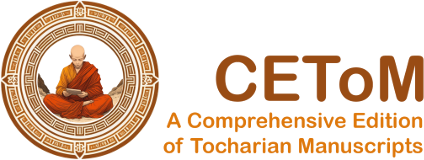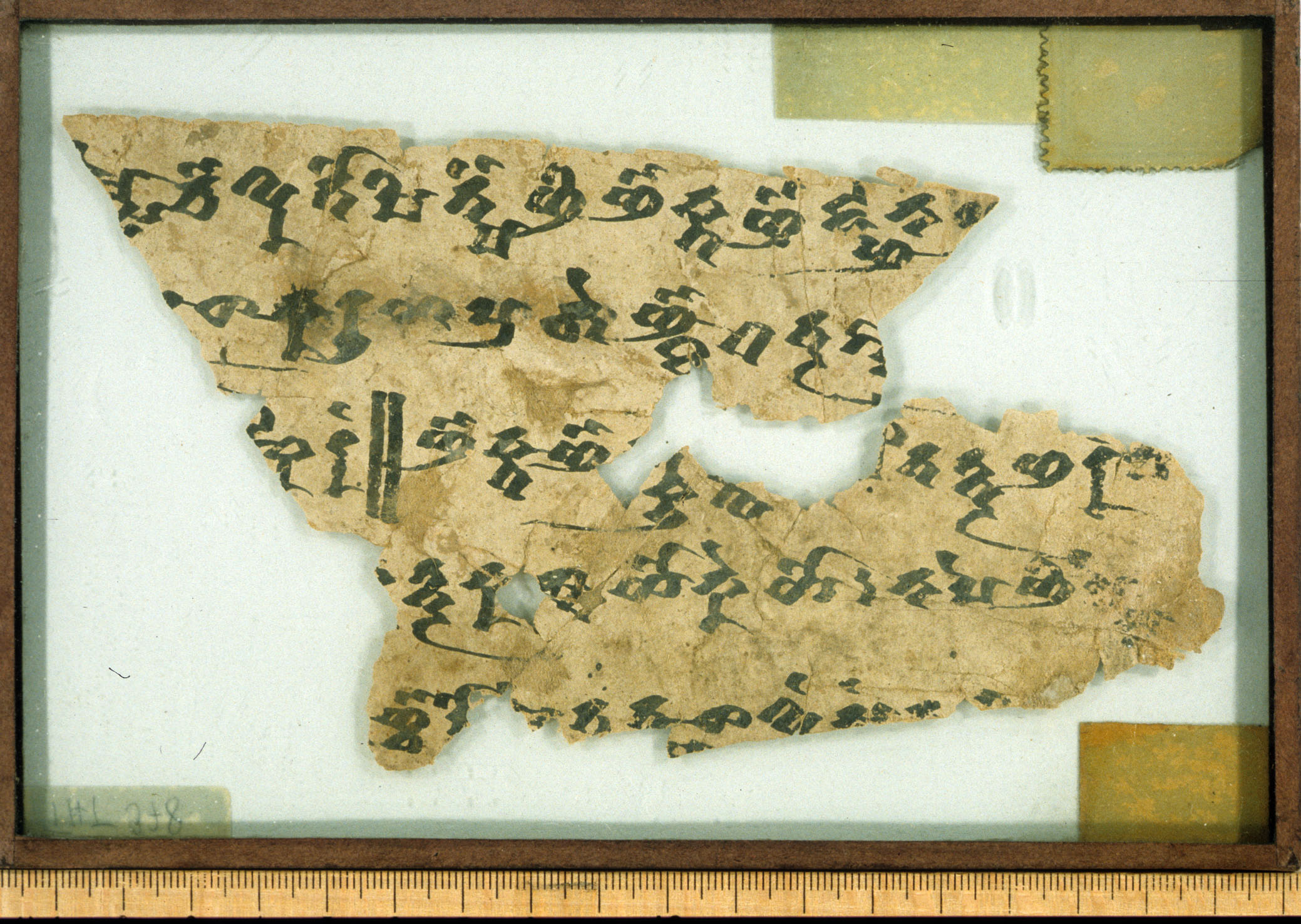A 344
| Known as: | A 344; THT 978 |
|---|---|
| Cite this page as: | Michaël Peyrot; Bernhard Koller. "A 344". In A Comprehensive Edition of Tocharian Manuscripts (CEToM). Created and maintained by Melanie Malzahn, Martin Braun, Hannes A. Fellner, and Bernhard Koller. https://cetom.univie.ac.at/?m-a344 (accessed 02 Jul. 2025). |
Edition | |
| Editor: | Michaël Peyrot; Bernhard Koller |
| Date of online publication: | 2015-11-23 |
Provenience | |
| Main find spot: | Shorchuk |
| Specific find spot: | Stadthöhle |
| Expedition code: | T III Š 63.08 |
| Collection: | Berlin Turfan Collection |
Language and Script | |
| Language: | TA |
| Script: | classical |
Text contents | |
| Title of the work: | Araṇemijātaka |
| Passage: | a |
| Text genre: | Literary |
| Text subgenre: | Jātaka/Avadāna |
| Verse/Prose: | prose; verse |
| Meter: | 43434 (4x) |
Object | |
| Manuscript: | Araṇemi |
| Material: | ink on paper |
| Form: | Poṭhī |
| Number of lines: | 5 |
Images
Images from idp.bl.uk by courtesy of the International Dunhuang Project, the Berlin-Brandenburgische Akademie der Wissenschaften, and the Staatsbibliothek zu Berlin – Orientabteilung.
Transliteration
| a1 | /// – – (–) – – /// |
|---|---|
| a2 | /// – • sū ccā¯ ¯cä • pa śi mā ca¯ ¯r l· l· [t]s· |
| a3 | /// – lu prā¯ ¯cä tā k[m]ä¯ ¯s || tā pa¯ ¯rk pa¯ ¯lts• |
| a4 | /// – ne sa¯ ¯m pu tti śpa rna[¯] [¯cä] ske y· [y](·)āṃ (–) – |
| a5 | /// slu(·)¯ ¯t pa ltsa kyo pa klyo s̝a¯ ¯s ca¯ ¯m cā t· [k]ṣ· /// |
| b1 | /// mse¯ ¯cä wu to ṣi tṣä ñi ñä kta ñä jñā na [pra] /// |
| b2 | /// [ra]¯ ¯s̝ ka ru ṇa pra bhe ñkä¯ ¯t tra ṅ[ka] (–) – /// |
| b3 | /// ṅkā raṃ || ñä kta¯ ¯ñä ·[u]ku· [t]w· – li ta ntra ña re ṣ[i] |
| b4 | /// ntra ka[¯] [¯]s̝t yo ke yo : na pe ñi ṣme |
| b5 | /// ¯ñcä [ṣ]o me t· t[m]·¯ ¯s̝ w(·)·ṃ saṃ – – – – |
Transcription
| a1 | /// – – – – – /// |
|---|---|
| a2 | /// – • sūccāc • paśi mācar l·l·ts· |
| a3 | n1 /// – lu prāc tākmäs ॥ tāpärk pälts¬ |
| a4 | (äk)n2 /// – ne säm puttiśparnac skey· y·āṃ – – |
| a5 | n3 /// (sā)slu(ṃ)t pältsäkyo päklyoṣäs cam cāt(a)kṣ(i) (ma)¬ |
| b1 | (säk) /// (tmäṣ) (ku)mse{ṃ}c wu toṣitṣ{ä→i}ñi ñäktañ{†ä} jñānapra(bhe) – |
| b2 | n4 /// räṣ karuṇaprabhe ñkät träṅkä(ṣ) – /// |
| b3 | n5n6 /// (॥) (śmāśānaśrä)ṅkāraṃ ॥ |
| 1a | ñäktañ (s)uku(n)tw(äṣ) ; litanträ ; ñareṣib4(ñi)n7 4σ |
|---|---|
| 1b | 13σ /// nträ ; kaṣt yokeyo : |
| 1x | napeñi ṣme ; b5 (śärmeyo) ; 11σ |
| * | /// ñc ṣome t(a)tm(u)ṣ w(ra)ṃ saṃ – – – – |
|---|
Translation
| a1+ | ..., Sūccāc, mother Paśi, ... |
|---|---|
| a3 | ... may we be (?). |
| a3+ | || Now ... [your] mind ... |
| a4 | ... he (made?) efforts for the Buddha rank ... |
| a5+ | With concentrated mind listen to this Jātaka (linkage)! |
| b1 | (Thereupon) the two Tuṣita-gods, Jñānaprabha (and Karuṇaprabha) come. |
| b2 | .... the god Karuṇaprabha says: «... |
| b3 | ... (|| In the śmāśānaśrä)ṅkāraṃ [tune] || The gods are falling down from [their] happinesses, |
| b3+ | the hell [beings] (are tortured by suffering (?)) ... |
| b4 | (the hungry ghosts) are (struck) by hunger [and] thirst. |
| b4+ | [1b] Humans (are tortured (?) by) the wet season ([and] by heat (?)) |
| b5 | ... Some are born in water ... |
Commentary
Remarks
| Transcription and references have been transferred from the "Text and Reference Database of the Tocharian A Language" (Gerd Carling Lund University) (funded by the Bank of Sweden Tercentenary Foundation and SCAS). | |
| Transcription and translation are based on Carling et al. 2009. | |
| This fragment must be placed before A 343 and A 342. However, it is unclear how many leaves are missing between these three fragments. This fragment, i.e. A 344, contains the beginning of the Araṇemijātaka. Lines a1–3 apparently mention donors and end with a pious wish. Lines a3–4 may mention briefly the general topic, and perhaps the title of the jātaka or the name of the protagonist, Araṇemi. Line a5 calls on to the reader, perhaps in the original setting the listener or spectator, to listen carefully. Lines b1–5 contain a frame story, a kind of Prolog im Himmel, to the actual jātaka. In this frame story, the gods Jñānaprabha and Karuṇaprabha comment on the world below. One of them speaks the strophe starting in line b3, which is of general content. Probably they will subsequently more specifically introduce the story of Araṇemi. The Tocharian B fragment THT 77 covers roughly the same passage, but a close parallel is found only between A 344 a5 and THT 77 4–5. |
Parallel texts
| THT 77 |
Philological commentary
| : The two Tuṣita-gods, who are called Jñānaprabha and Karuṇaprabha here, are called Jñānasthita and Guṇasaṃpada in the Tocharian B version. | |
| : Sieg 1952: 34 suggests ñareṣi(ñi klopantyo) 'the hell [beings] (suffer from sorrows)'. | |
| n1 | tākmäs: If for tākamäs, this is a preterite. Possibly, it is for the optative tākimäs 'may we be', since often wishes of this type are found in colophons and introductory passages. Note, in any case, that the spelling is not correct: it is written tākmäswith regular k and m instead of tākmasor tākmas. |
| n2 | skey· y·āṃ: The restoration is uncertain. One would expect the obl.pl. skeyas (not found here) followed by a verb. |
| n3 | cāt(a)kṣ(i masäk): This term refers to the identification of persons in the jātaka with persons from the present, i.e. the Buddha and persons from his life. Normally, this identification is found at the end of a jātaka, not at the beginning, so that this restoration (already by Sieg 1952: 34) must remain uncertain. |
| n4 | /// räṣ: Certainly an absolutive, for instance (täm kaklyuṣu)räṣ 'having heard this' or (täm pälko)räṣ 'having seen this'. |
| n5 | (śmāśānaśrä)ṅkāraṃ: This is the only tune name ending in ṅkāraṃ; the metre is 4 x 7/7/4. |
| n6 | (s)_uku(n)tw(äṣ): Sieg 1952: 34 interprets "fallen (von) [ihren] Glücks[-Himmeln] herab". |
| n7 | /// nträ kaṣt yokeyo: The context clearly requires 'suffer from hunger and thirst', but the restoration of the verb is uncertain. Palaeographically excluded is (kärntsa)nträ 'are struck', as in A 320 a5 kaṣt yok(e)yo kakärnuṣ ṣeñc 'were struck by thirst and hunger'. yokeyo is the end of pada 1b. |
References
Online access
Edition
Sieg and Siegling 1921: 189-190; Sieg and Siegling 1921 p. 189, p. 190
Translations
Schmidt 1974: b3 (112); Schmidt 2001: a5 b1 b2 (299, 302); Sieg 1952: a1 a2 a3 a4 a5 b1 b2 b3 b4 b5 (34)
Bibliography
Carling, Gerd, Georges-Jean Pinault, and Werner Winter. 2009. A dictionary and thesaurus of Tocharian A. Volume 1: Letters a-j. Wiesbaden: Harrassowitz.
“The International Dunhuang Project: The Silk Road Online.” n.d. http://idp.bl.uk.
Schmidt, Klaus T. 1974. “Die Gebrauchsweisen des Mediums im Tocharischen.” PhD, Universität Göttingen.
Schmidt, Klaus T. 2001. “Die westtocharische Version des Araṇemi-Jātakas in deutscher Übersetzung.” In De Dunhuang à Istanbul. Hommage à James Russell Hamilton, edited by Louis Bazin and Peter Zieme, 299–327. Silk Road Studies 5. Turnhout: Brepols.
Sieg, Emil. 1952. Übersetzungen aus dem Tocharischen II, aus dem Nachlass hg. v. Werner Thomas. Abhandl. d. Deutschen Akad. d. Wissenschaften zu Berlin, Kl. f. Sprachen, Literatur und Kunst 1. Berlin: Akademie-Verlag.
Sieg, Emil, and Wilhelm Siegling. 1921. Tocharische Sprachreste, I. Band. Die Texte. A. Transcription. Berlin/Leipzig: de Gruyter.
Sieg, Emil, and Wilhelm Siegling. 1921. Tocharische Sprachreste, I. Band. Die Texte. A. Transcription. Personal annotated copy of Wilhelm Siegling. Scanned by Douglas Q. Adams with the technical assistance of Michael Tarabulski and Kevin Dobbins. Berlin/Leipzig: de Gruyter.
Gippert, Jost, Katharina Kupfer, Christiane Schaefer, and Tatsushi Tamai. n.d. “Thesaurus Indogermanischer Text- und Sprachmaterialien (TITUS): Tocharian Manuscripts from the Berlin Turfan Collection.” http://titus.fkidg1.uni-frankfurt.de/texte/tocharic/thtframe.htm.




